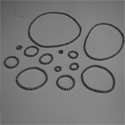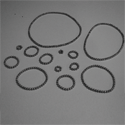Laws of the rings
Polymerization is the random bonding of initially isolated monomers to form polymer chains or clusters. Bonds may also be severed, leading to fission. As polymerization proceeds, gelation can occur, that is, the emergence of a “giant” cluster containing a finite fraction of the monomers in the system. Gelation kinetics have been studied for decades using a mean-field theory of the percolation phase transition, but now, writing in Physical Review E, Eli Ben-Naim of Los Alamos National Laboratory and Paul L. Krapivsky of Boston University add a new twist to this venerable subject by restricting clusters to be ring-shaped. Their topological constraint is a consequence of strong dipolar forces between the monomers in their model. Their reversible, stochastic model, starting with a system of monomers, evolves via mergers of pairs of rings and the inverse process, fragmentation.
Starting from a configuration of isolated monomers, larger rings form until gelation occurs. In general, in the simulations, several giant rings emerge in the system after gelation, whose sizes fluctuate drastically over time. During the subsequent evolution, the cluster-size distribution approaches a simple form to where the number of clusters is inversely proportional to the cluster size, up to a cutoff size, which itself slowly grows with time. Eventually, the cutoff size reaches the system size , at which point almost all the monomers are found in giant rings. The mean number of rings in the final state is nonextensive, growing logarithmically rather than linearly with system size, bearing out the authors’ theoretical predictions. – Ron Dickman





